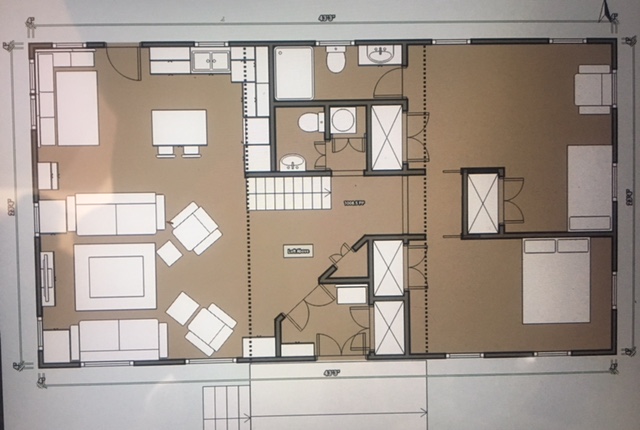Reader JOY in PHILADELPHIA writes:
“Can I build my pole house with crossed gable dormers? I want the center section of my house to have a second floor, but with the gable ends facing front and back, rather than running the length of the building as with the monitor roof design. (In case that isn’t clear, an aerial view of the roof would look like an cross.) The building would be 24 D (sides) x 44 L front and back,) with the intersecting roofline the 24 depth and 13 wide.)
Which leads to what kind of support would be needed for the floor and wall above the side walls of the dormers? I’m assuming that the roof pitch would need to be steep enough so that moisture wouldn’t be a problem where the side walls of the dormer meet the main roof. (Although I’m not sure what that pitch is.)
The dotted lines indicate where the second floor is placed in the attached image.”
 Mike the Pole Barn Guru says:
Mike the Pole Barn Guru says:
YES.
In fact nearly any conceptual home can be constructed as a post frame (pole) building – nearly always at a cost savings.
But wait, there is more…..
You can multiply your cost savings by doing the assembly work yourself. Tens of thousands of people just like you have successfully constructed their own post frame buildings and houses!
Your request is actually far more straightforward than many proposed buildings we see. Think of the center portion (13 feet wide x 24 feet), which is two stories in height, as being a building unto itself. Columns will support the second floor (and subsequent roof) and can be “buried” in the walls of the lower floor.
The “wings” on each side of the center portion are “reverse gables” (read more at: https://www.hansenpolebuildings.com/2015/07/reverse-gable-porch/).
A few years back, my lovely bride and I, along with our son Jake constructed a similar style roofline building as a mother-in-law apartment and garage in Jake’s backyard in Tennessee:
In most instances, all of the roof slopes would be the same and at least 4/12. Flashing is installed underneath the siding of the tall portion, extending over the roofing of the lower portion to eliminate roof leaks.






